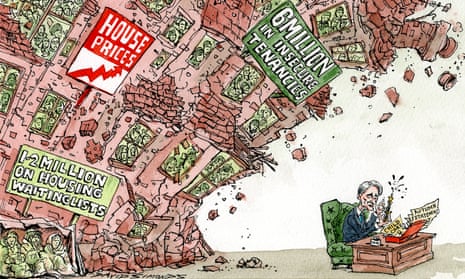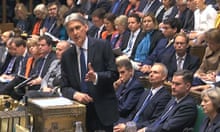A boost for childcare in the autumn statement would be a profoundly depressing move. And it will be just as dispiriting if there are new programmes to help low-income families. Not because these measures aren’t to be warmly welcomed: it is just that it will tell you that the chancellor is focused on tinkering rather than boldly tackling the most pressing crisis of the age: housing.
Last week saw several heavyweight reports into Britain’s housing crisis. The Redfern review, detailing the catastrophic slump in home ownership, told us how real house prices have jumped 151% since 1996, while real earnings have risen only about a quarter as much.
The report by the ResPublica thinktank, out the next day, told us how 1.2 million people are languishing on housing waiting lists in England, while more than 6 million face tenure insecurity and no prospect of ever buying their own home.
Meanwhile the Lyons Housing Commission reminded us last week how, after decades of failure to build the homes the country needs, public concern about housing is the highest it has been for 40 years.
Not that today’s millennials need researchers to tell them about punishingly high rents, one-bed flats costing seven times income, and deposits on new homes that take nearly a lifetime to save. The difference now is that the grown-ups accept that action is urgent – not least because they’re approaching retirement and the kids have still not left home.
The problem with housing is that to make a real impact, the sums of money required are truly colossal. Britain’s housing stock is worth £6 trillion. A billion or two, sprinkled here and there on HomeBuy (2005), Open Market HomeBuy (2006), First Buy (2011) and Help to Buy (2013) has been a waste of taxpayers’ money. During the lifetime of these schemes, fewer and fewer young adults and families have been able to buy. It takes tens of billions to actually make a difference.
The standard refrain is that we don’t have tens of billions. Cranking up building to the 200,000 units a year most experts say we need as a minimum remains a dream; we don’t have the money, the land or the workers to build them. Yet in 1951 politicians – from the Conservative party, no less – set out a plan to build 300,000 units a year, at a time of much greater austerity, and when the national debt was 200% of GDP compared with 89% now.
Harold Macmillan, the wartime minister of supply, was charged with hitting the 300,000 target. Among his requests was for “2,000 million bricks”.
Oddly, the Redfern review last week suggested that boosting housing supply will do little to help first-time buyers, and that house prices will remain out of reach. This is unduly pessimistic; a history of British house prices tells you how they remained flat through much of the 1950s and early 1960s, precisely when supply was at its most vigorous – around 400,000 units a year at its peak. We knocked out just 140,000 last year.
Finance is cheaper than the 1950s, with even Brexit failing to disrupt the government’s ability to borrow at historically low levels of interest. The money markets are awash with investors happy to accept returns of 1% or 2% a year; housing associations and local authorities are desperate to build both private and public housing. We urgently need to break this logjam, and if not now, then when? Never has there been such near-universal acceptance of the need to act.
But while funding is the most important issue, it’s far from the only one: what do we do about planning permission, the green belt, new towns, developers’ land banks, inefficient building methods, minimum space standards and reviving the small and medium-sized housebuilding sector? And the type of housing we build is as important as the volume.
Crucially, we need a vision. What we’ll find out this week is whether Hammond has inherited the one-nation instincts of Macmillan, or the dreary austerity of Osborne.
Central bankers fight the brickbats
Janet Yellen is going nowhere. She will serve out her full term as chair of the US Federal Reserve. At least that is what she said in her first remarks since the upset that handed the US presidency to Donald Trump – a man who was openly critical of the Fed on the campaign trail and said he would replace Yellen when her term expired.
But Yellen made it clear she would not be cowed into an early exit – and she also stood firm on the Fed’s intentions to raise US interest rates soon, to reflect an improving jobs market and rising inflation.
This is the latest showing of central banker defiance in the face of political meddling. In the UK, policymakers at the supposedly independent Bank of England have been defending their role after prime minister Theresa May broke with protocol and talked about “bad side-effects” from low interest rates and quantitative easing. The Bank’s governor, Mark Carney, seemed unimpressed, commenting days later: “We are not going to take instruction on our policies from the political side.”
Downing Street apologised, insisting that May had not intended to attack the governor. But her comments prompted open criticism of Threadneedle Street and Carney from senior Tories and sparked a debate over the Canadian’s future at the Bank.
Last week it was deputy governor Ben Broadbent’s turn to fight the Bank’s corner, as he argued that low rates had not driven up inequality.
It’s a similar story in the eurozone. Amid nervousness over the rise of anti-establishment movements, the European Central Bank president, Mario Draghi, has been forced to fend off accusations that it is partly to blame. Germany’s finance minister, Wolfgang Schäuble, said rock-bottom interest rates were hurting savers and fuelling rightwing nationalism.
It has been open season on central bankers and experts in general this year. But if and when Yellen is forced to remind President Trump that central bank independence is not a matter for debate, she will be in good company.
Asda needs more than price cuts
Walmart-owned Asda has just revealed its ninth consecutive quarter of declining sales as German discounters Aldi and Lidl eat its breakfast, lunch and dinner.
Asda’s new boss, Sean Clarke, insists the grocer’s fortunes are on the turn as carefully targeted price cuts and a decision to put more staff in stores begins to bring back shoppers. Year-on-year sales are now down “only” 5.8%, rather than the 7.5% of three months ago.
Tesco has shown it is possible to win back customers by sorting out the basics – like better service and lower prices on everyday items from bread to apples.
But Tesco has always traded on broad appeal. Asda’s historical focus on price gives it a much harder job. It is already the cheapest of the major grocers, but is the worst performing by a large margin. It needs to be smarter and more inventive, and put some excitement back in its stores. It needs bigger ideas than just price cuts.









